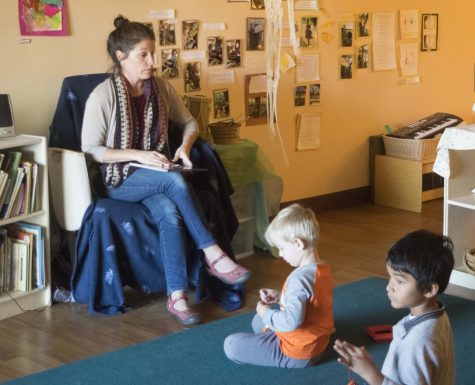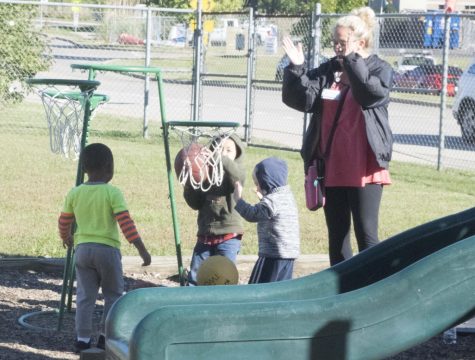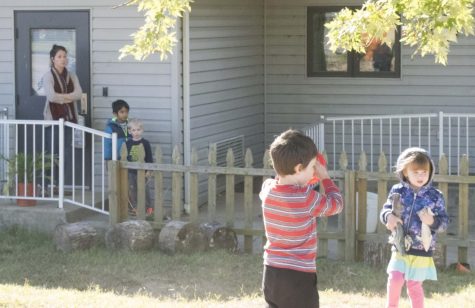After hours: cultivating young minds

Children at the USI Children’s Learning Center wait patiently for story time. Melanie Hayford works as a part-time teaching assistant at the center.
Every week The Shield will feature a student who is employed by the university. This week, Melanie Hayford talked about her experience working at the USI Children’s Learning Center.
Melanie Hayford takes the children from the Children’s Learning Center on walks around campus. They go to the woods, utilize the trails, look at the fountains and teach the children about the university.
“We call it the ‘big school’ because that makes sense in their head,” Hayford said. “We have a lot of interactions with the college students. When it becomes finals time, we will package up little candies, and the kids take them on to campus, and they’ll hand them out. That really excites the kids because they get to see the big kids.”
The senior early childhood and elementary education major worked at the Children’s Learning Center for a year before getting the position of a part-time teaching assistant after going through an application and interview process.
Hayford had experience in babysitting and working at the YMCA in the child watch area and already finished her early childhood education classes before applying for the job.
“For a lot of my early childhood classes, I was actually at the center as a student, so I was able to observe how the teachers taught,” Hayford said. “I knew what to expect coming in, as a student worker and as a teacher because I had done the observations through my USI classes.”
On Mondays and Wednesdays, Hayford spends the first part of her day at West Terrace Elementary School for one of her classes before going to the center at 11:30 a.m. She goes into one of the classrooms and helps with lunch and the nap that follows.
When Hayford gets downtime, she helps with documentation, cleaning and anything else the teachers need. After the nap, the children receive a snack before playing outside for the rest of the afternoon.
Hayford said one of the big things she’s going to take from the job is respecting children.
“Children are very much capable, and they’re competent to do things,” Hayford said. “A lot of times we think of little children as, ‘oh, they can’t do that’ or ‘don’t let them do that because that’s scary.’ But I think it’s opened my mind to all the things children can do.”
Hayford learned that it’s okay to let children fail as long as they’re learning.
“It’s a great experience for any student,” Hayford said. “Even if it’s just a student worker position from any student on campus, but definitely an education major because you’re getting the experience of a future job once you graduate.”
Jamie Madigan looks for students who are self-starting and self-disciplined with high work ethic and communication skills to work at the Children’s Learning Center.
Madigan, manager of the Children’s Learning Center, described the center as a child care program for learning, education and parent care services for children aged two to five. The center utilizes three different classrooms, with one used for children aged two to three and the others used for children aged three to five. The center is open from 7:00 a.m. to 5:00 p.m. from Monday to Friday.

Children play outside the USI Children’s Learning Center with a student employee. The Center is now looking for student applicants.
“The curriculum and education components are embedded within the care,” Madigan said. “All day, there are small group activities, large group activities, hands-on play, math, science and social studies all embedded in the activities the teachers plan on a daily or weekly basis.”
According to Madigan, in regards to enrollment, the children of students get first priority followed by staff and faculty, and any vacancies left over can be filled by the children of people outside the university.
“We’re known for high quality,” Madigan said. “We’re the only nationally accredited center in the 47712 zip-code. We have the campus coordination and collaboration with other courses in order to have the students come over and work with the children from the nursing department or the psychology department or the education department.”
The center currently has four teaching vacancies along with a substitute vacancy. These include two part-time teaching assistant jobs. Madigan said the part-time teaching assistant position would be the best fit for students.
Part-time teaching assistants work in all three classrooms. Their duties include assisting with child care, helping the teachers and working on daily cleaning chores. Students in this position could work up to 27 hours a week.
Applicants can include education majors, social work majors, elementary education majors, special education majors and early childhood education majors. People with associate’s degrees in one of those fields are preferred and a driver’s license is required. The center needs students that can work after finals and during some of the winter break.
“Staffing is quite difficult for a full year, full time, program that runs with the majority of our students being employees,” Madigan said.
Madigan said the best people to fill the teaching positions are people with life experience. This includes coursework and hands-on work experience in jobs like babysitting, Holiday World, summer camp jobs or church nurseries.
“Those kinds of prior experiences tend to lend them to being more hands-on and ready to jump in and do the job,” Madigan said.
Madigan said almost all of the over 150 people she hired in less than four years have been excellent employees
“They tend to leave because of scheduling conflicts or leaving here to do practicum hours or student teaching, mainly to complete their degree,” Madigan said. “I need someone who can actually jump in and do the job because we care for children 50 hours a week and training just tends to be hands on.”
Madigan said seeing the children playing on campus or on the playground brings up a smile, a sense of freedom, curiosity and an eagerness to learn.
“A child-like mentality is free of woes, and you’re not thinking so much about ‘adulting,’” Madigan said. “When you see things through the eyes of a child, it’s much more pleasant and great to have the creativity and inspiration from a young child.”
Madigan said, in a corporate world, child-care increases work productivity.
“For those going to school or working on campus, they can feel that their child is in a safe, loving, environment and learning the skills that they need to be ready for school and higher education in the future,” Madigan said. “Eighty percent of pre-kindergarten year learning is all to get an inspiration for a love of learning and curiosity so that they want to know more.”

The USI Children’s Learning Center is open Monday through Friday from 7 a.m. until 5 p.m.
Madigan said students who work at the center gain a great job and high recommendations from being employed there.
“The book knowledge is important, of course, for higher education but practical application, I believe, is more important,” Madigan said. “Understanding that children learn things in a sense of ‘I am the center of the world,’ all the way to how to be a productive member of society, each stage in between those steps are very important so a child can know that working cooperatively with someone else is a lifelong skill.”
Madigan said the staff at the center is a great team.
“We are like a small family,” Madigan said. “We feel like we help each other by collaboratively learning as adults, we learn from each other, we learn from the children, we learn with the children, and the love of learning is evident, not only in the children but in the staff.”


